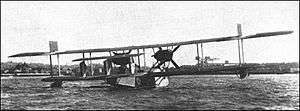Vickers Valentia
For the troop transport, see Vickers Type 264 Valentia.
| Valentia | |
|---|---|
 | |
| Role | Flying boat |
| Manufacturer | Vickers-Armstrongs |
| First flight | 1921 |
|
| |
The Vickers Valentia was a British flying boat designed during the First World War.
History
Three Valentia prototypes were built by the Vickers Company at their Barrow works (Walney Island perhaps), having been ordered in May 1918 as a potential replacement for the Felixstowe F.5. Two were cancelled when the First World War ended, and the third went to the S.E.Saunders works at Cowes for completion. Stanley Cockerell began test-flying it over the Solent in March 1921.[1] The airframe crashed and written off during June 1922.[2]
The name was later re-used for a transport aircraft.
Specifications (Valentia)
Data from Vickers Aircraft since 1908 [3]
General characteristics
- Length: 58 ft 0 in (17.68 m)
- Wingspan: 112 ft 0 in (34.15 m)
- Height: ft in (m)
- Empty weight: 10,000 lb (4,545 kg)
- Loaded weight: 21,300 lb (9,682 kg)
- Powerplant: 2 × Rolls-Royce Condor piston engine, 600 hp (448 kW) each
Performance
- Maximum speed: 105 mph (168 km/h, 91 kn)
- Endurance: 4 hours 30 min[4]
Armament
- Guns: Provision for two Lewis guns. Tested with COW 37 mm gun[4]
See also
- Canadian Vickers - Felixstowe F-III built for transatlantic attempt
- Related development
- Aircraft of comparable role, configuration and era
References
| Wikimedia Commons has media related to Vickers Valentia. |
- Andrews, C.F and Morgan, E.B. Vickers Aircraft since 1908. London:Putnam, 1988. ISBN 0-85177-815-1.
- London, Peter. British Flying Boats. Stroud, UK:Sutton Publishing, 2003. ISBN 0-7509-2695-3.
This article is issued from Wikipedia - version of the 8/22/2015. The text is available under the Creative Commons Attribution/Share Alike but additional terms may apply for the media files.